The Second Life Science Center
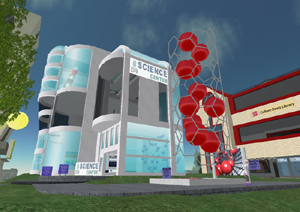 Second Life Science Center |
I’m a Second Life tourist. I don’t own property or buy things or invest anymore interest in Linden’s virtual world beyond wandering around taking in all the amazing things the world’s user-base comes up with, snapping pictures, and talking to people all over the world. One of the first places I had to visit when I joined SL was the Science Center. There’s a growing body of science displays and museums in SL and I was very impressed with this set up.
Standing tall in to one side of the center is a giant carbon nanotubing model provided by the National Physical Laboratory (NPL) It includes a 3-d video demonstration of the tubing in action with atoms actually flowing through it. For some reason it rarely seems to work though. It wasn’t until my third visit to the center that I actually got it to run, which is a shame because it’s a nice demo.
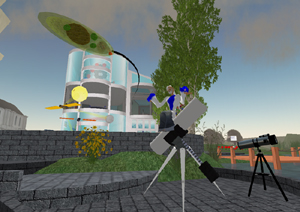 My Avatar Chillin’ |
Wandering around the grounds outside, I found a genetics display titled “Independent Assortment in a Dihybrid Cross,” featuring a variety of red and white and short and tall flowers in a garden. It demonstrates Mendel’s Law of Independent Assortment, that the genes for red and white are inherited independently of the genes for short and tall. Clicking on the display progresses the garden to the next generation of flowers. A larger genetic museum located in SL is The Gene Pool, which I plan to visit in the future.
A giant rotating model of a euglena, a single-celled organism with a flagellum, also resides outside the center. When you get close to it, labels appear identifying it nucleus, chloroplast (misspelled “cholorplast”), eye spot, and other features. A two-dimensional display of images further detail the organism’s structures.
I took the load off of my virtual feet by sitting on a telescope, which apparently do not serve any purpose in SL other than as decorations. At least, I was never able to figure out how to use one, which is weird because they have them all over the place. Somebody correct me if I’m just too much of a dunce to figure it out. You can see the giant euglena in the background of this picture.
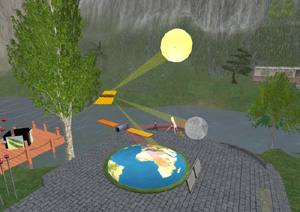 TRUTHS Satellite Calibration Display |
NPL has another exhibit outside titled “TRUTHS: A future satellite to underpin climate research.” Apparently Earth Observation (EO) satellites lose some of their accuracy after being calibrated due to storage and space exposure. The TRUTHS satellite will focus on calibrating itself based on the Sun, Moon, and Earth. This calibration will then be used to calibrate other satellites in orbit, improving accuracy of the EO fleet. Accompanying this data is a model of the satellites in their relative positions to the celestial bodies.
The first thing you are confronted with inside the center is a giant model of a Buckminsterfullerene molecule, also known as the carbon buckyball. Composed of 60 carbon atoms, it is theorized that this molecule could capture atoms, similar to the way the carbon nanotubing could be used to transport them. All of that’s cool and whatnot, but I was more interested in a moment of Zen floating inside this fantastic structure.
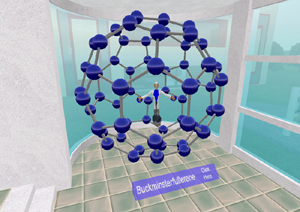 Carbon Buckeyball |
Okay, so I’m embarrassed to say it took me two or three visits to the Science Center to figure out how to get upstairs to the other exhibits, but after much bonking my head into the second and third story windows like some demented oversized bird (SL avatars can fly), I figure it out (teleportation).
The second floor (inaccurately named the first floor) has exhibits demonstrating protein synthesis on cellular ribosomes, optical illusions, and a language illusion I didn’t understand. Maybe that’s an advantage to RL museums, I can grab someone and say, “Excuse me, but WTF?” To which they might reply, “O RLY?” and I’d be all like “YA RLY!” – If people spoke like that in RL.
There’s also a gravity well demonstration, which, if this were a real life museum, I would have been asked to leave after scattering balls all over the place in my eagerness to see planets collide and wash down the black hole. Luckily, SL demos usually have a timed reset feature, so the museum cleaned itself up.
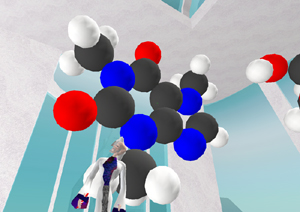 Mmmmm… Giant Caffeine Molecule |
The top floor (accurately named) features giant models of three molecules: aspirin, caffeine, and sucrose. Unfortunately, there wasn’t anything else to the top floor display beyond this.
Back on the first floor, several links take you to sources on the World Wide Web with additional information. Additionally, I found an SL link here for the NOAA’s island of exhibits. Some of these sounded outright fantastic, and I immediately had to rush out to take a look.
But the NOAA was closed, all I could do was stare from the island’s entry point at the exhibits beyond the gate. It was like that scene in National Lampoon’s Vacation, when the family gets to Wallyworld and it’s closed… only I simply clicked on a link and teleported there instead of driving cross-country for a week and experiencing an abundance of misadventures. Click. Swoosh! (Why can’t we fly and teleport in RL???)
Still… NO FAIR!!! I wanted to see the Weather Balloon! I wanted to chill out on the Glacier! I wanted to witness the Tsunami! I wanted to hop on the Hurricane Ride! I wanted to hang with Flipper at the Sea Life exhibit! I wanted to experience the Earth-shattering iconoclasm that is the “Meeting Hall,” and what the heck is “Science on a Sphere” anyways?
The International Space Museum
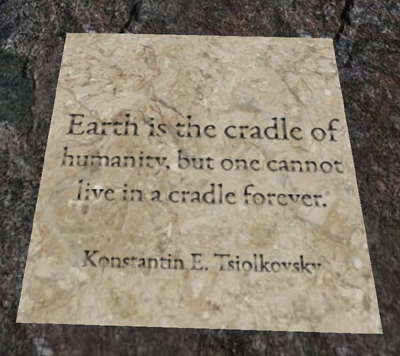 Welcome to the International Space Flight Museum in SL |
The first thing you see when you teleport into the International Spaceflight Museum (ISM) in Second Life is the above quote from the great pioneer of cosmonautics Konstantin Tsiolkovsky.
Then you look up and see the towering models of all sorts of different rockets in the distance. There are models of the lunar lander, rover, command/service module, models of the moon with the lunar landing sites, models of just about EVERY SINGLE FREAKING ROCKET IN THE HISTORY OF SPACE FLIGHT rendered in scale and detail. There are a lot of models at the ISM. It’s like a botanical garden of space flight vehicles.
 ISM Rockets Display |
Among the more interesting displays were boxes you can walk into and find simulations of the space capsule and shuttle interiors. The effect was an eery one. The displays used real pictures of the interior spread across the insides of the model cockpit. It was a cool and realistic display technique and one I’d like to see used elsewhere in SL museums.
A Real-time Satellite Propagator (RSP) presented a large globe rendering Earth with the present location of various satellites. There was a control panel, which I believe would allow you to select the satellites you were interested in viewing, but it wasn’t operable. Among the options for satellites were Sirius and DirectTV. The globe was showing the present location of the Hubble Space Telescope (HST), but I didn’t see an option for the International Space Station, which I was interested in because it can be seen with the naked eye, even in Cities.
 Second Life Planetarium |
The notecard for this display also had a nifty link to satellites and space debris currently tracked in orbit, along with PDF descriptions of what they are. There were also a few smaller displays demonstrating types of satellite orbits and interactions with Earth.
The Second Life Planetarium had a show about the constellations. The planetarium was less interesting than the fact that this was the largest collection of avatars I had yet to find in one place. They were hanging around outside the doors waiting to get in. There was one dancing in the air while we awaited our turn at the show.
Check out the dork in the background with the rocket pack! Who’s he trying to be anyway, that albino from the movie Powder? Where’s the “Wedgie” button on this thing? Or maybe the “Wet Willy.” He’s totally got it coming to him.
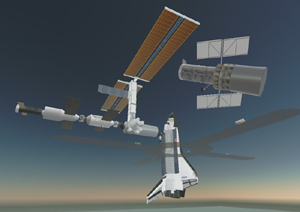 Shuttles and Space Stations and Hubble Oh My! |
A series of teleportation nodes carried me way up into the sky, farther than avatars can naturally fly in SL. Each teleportation took me to a different platform with a display. There were models of the planets and human engineered space objects, each with facts on the display. If you can find a partner to come with you, the display has a rocket-ride up to the platforms.
Of course, at the end, I couldn’t resist walking off the platform to freefall alllllllll the way down through the atmosphere to fall flat on my face… and then get up like it was nothing.
A robotic arm at the base of the space-voyage display allows visitors to take the controls and play with moving cargo around themselves.
I spent some time perusing the gift shop. There were free books on the History of Cape Canaveral, Stages to Saturn, detailed NASA Flight Plans (PDF Warning), and Moonport: A History of Apollo Launch Facilities and Operations As far as virtual objects for sale, there were model rockets, virtual space apparel, posters and art.
There were also telescopes for sale around $1200 (linden dollars). Unlike the telescopes I’ve found everywhere else in SL, which appear only useful for sitting on, these actually worked. They contained slideshows of celestial objects rendered in moderate detail.
Outside the gift shop was a series of newspaper vendors; although, being virtual, only one tried to look like the newspaper vendors we have in real life.
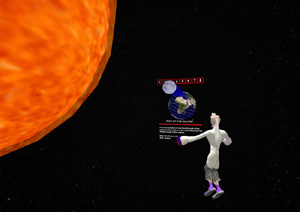 Aimee Weber’s Exploratorium |
Next door to the ISM, I found Aimee Weber’s Exploratorium, a large, modern-looking building with a coi pond on the roof. Here were several different models of how a lunar eclipse works, and I think they were all helpful in understanding the process. There was also a tour of the solar system and several diagrams of Earth’s local space.
A “Coming soon…” sign also neighboring the ISM heralded the future site of “Explorer Island” future SL home of the Jet Propulsion Laboratory (JPL). The science sector of Second Life is growing faster than any prime-realstate in real life.
NASA’s COLAB
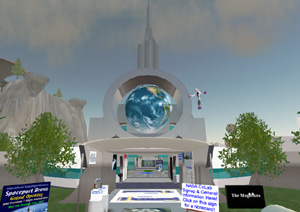 COLAB Headquarters in SL |
Right next door to the ISM in SL is NASA’s COLAB. I visited COLAB when it was just in the planning stages a few months ago and was suprised to find that the island has exploded into a myriad of displays… or more specifically, experiments.
The COLAB is collaborative effort, experiments and displays built by volunteers. It’s main building is still in a state of construction, but there are plenty of other items on the island worth checking out.
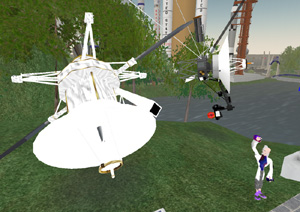 Magellan and Voyager Satellites |
I found my favorite satellite, Voyager, here. This deep-space probe is currently leaving our solar system after providing us with some stellar close up views of our planetary neighbors. Eventually, Voyager will fall into a wormhole, be discovered by a race of robotic life, and return to Earth with the upgrades they provide in the movie “Star Trek: The Motion Picture.”
There was also a model of the Viking lander, which may have discovered life on Mars in 1976. The Mars Pathfinder was also on display, and I learned that it was renamed the Sagan Memorial Station after landing on Mars July 4, 1997 in honor of Carl Sagan.
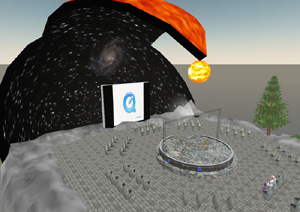 COLAB Theater and Lecture Area |
The Genesis Mission was memorialized with a slideshow and photograph of the team who worked on the project. Genesis collected particles of solar winds and brought them back to Earth.
A series of walkways take visitors up a rocky mountainside, which has a pleasant waterfall running down its face. At the peak, a lecture and presentation area provides both a view of the COLAB and an inspiring location for talks and films. The video display was showing old NASA news footage, and appeared to have rotating content.
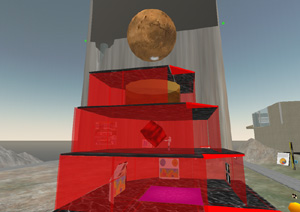 Mars Information Center |
A three-story building made of red glass serves as the Mars Information Center. A notable feature in this monument was Minerva, a chatbot in the form of a rotating cube intended to answer questions about Mars. After asking it questions about Mars for several minutes, all I was able to learn about the red planet was its diameter. It’s 6794 km at the equator and 6750 km at the poles… in case you were wondering.
The Mars Society has a display of what a dwelling on Mars would be like. I walked around this cylindrical house, and despite a comprehensive explanation of the floor plans and layout, the whole thing still felt rather 50’s retro to me. It was like wandering around somebody’s fantasy of living on Mars from the Cold War era. Still, kudos to them for what was still a fun display.
 Lavatube Base |
Dwarfing this display was a skyscraper-sized monolith of a structure called the “Lavatube Base.” Inside it was like an excavated cave, with giant modules inside. A COLAB voluteer I met here explained this was a model for a lunar living space that is to built in real-life. Inside each module notecards described how life was maintained, where inhabitants would keep their space suits, where they would bath, and how the water used would be recycled back into the system. Managing lunar dust seemed to be the biggest obstacle, and ionized suits and vacuum units were common solutions.
Right outside of this building I picked up a free Yuri Gagarin T-shirt. Yuri was the first human in space, and I found a “World Space Party” in his honor. Very hip.
NOAA
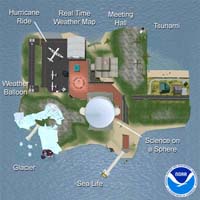 NOAA Island in Second Life |
The island is the creation of Aimee Weber, Second Life’s most well-known designer and most attractive avatar (She also made a nifty tour of the universe using Second Life, which you can see here (Quicktime Movie)).
The NOAA Conference Hall had Earth Day posters everywhere and several displays and slide presentations on human causes of global warming. There was also a poster for Rachel Carson, author of Silent Spring, the book that helped to jumpstart the Environmental Movement. Another poster summarized the career of George Davidson, who surveyed the West Coast of North America for six decades. A third poster introduced me to Col. E. Lester Jones, father of the NOAA Corps, and its remarkable contributions to the body of scientific research we have on our planet’s environmental systems.
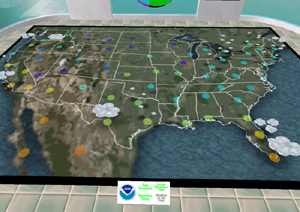 NOAA Real Time Weather Exhibit |
Opening a treasure chest labeled the “Treasure’s of NOAA’s Ark” on the Confrence Hall’s first floor starts visitors on a trivia scavenger hunt around the island. I didn’t have the time to find out what the prize was for completing the quest, but it seemed like a novel and fun way to get kids to fully explore the island.
On the first floor at the SL Science Center, there was this large map hosted by the NOAA. The same Real Time Weather display appears on the NOAA Island, housed in a warehouse-style building. It took me a couple of visits to figure out that this display shows real-time weather information for the United States. 3-D clouds and temperatures hover over the map. 3-D rain pours down wherever’s appropriate.
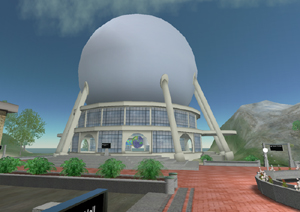 NOAA Science on a Sphere Exterior |
The Science on a Sphere exhibit is the largest building on the island. Avatars can pass through the giant dome on the top of the building and find a virtual reality display work in progress. It appears the the display will fill the interior of the sphere, changing environments using a control panel on a platform.
Below the sphere stands a model of the Earth in a separate room. Selecting items from a menu on a nearby wall allows visitors to view the Earth in different perspectives. A nighttime view shows the Earth covered in lights, artificial lights from developed countries and wildfires in the third world. A topography and bathymetry renders the Earth in 3-D, illustrating the trenches and mountain ranges around the planet. The Blue Marble view of Earth, assembled by NASA, is a mosaic of Earth-views put together to show what the Earth looks like on an average day.
 NOAA Science on a Sphere Display |
There are also land, ocean, atmosphere, and models perspectives of our spaceship Earth circling the Sun. Each view is accompanied with narration, explaining the significance and reasons for why the Earth looks the way it does.
A boardwalk running behind the SoaS building leads to an Ocean Life exhibit. A yellow submarine ride takes visitors on a tour of the aquatic display here. I opted instead to simply fly around the display on my own. Krill, sea anemonies, killer whales, schools of fish, kelp, underwater volcanoes, jellyfish, and dolphins fill this virtual lagoon. The killer whale and dolphins swam about on their own, apparently run by an internal AI mechanism, which wasn’t very smart. The whale often gets stuck in the shallower waters, and I’ve found beached dolphins here as well.
There were also many caves in this area, a link to a resource on the World Wide web in each one. Wandering around this display was like Easter-Egg hunting in an octopus’ garden, finding the many links hidden all around.
 NOAA Glacier Exhibit |
An enormous Glacier Exhibit allows view the time-lapsed effects of global warming. Clickin on an animation control panel causes the surrounding glaciers to melt away, simultaneously bringing the surrounding sea levels to rise up to the visitors virtual knees.
A Tiny hurricane merry-go-round, which played such wonderful little ditties as “Song of Storms” Legend of Zelda, the Beach Boy’s “I Get Around,” and “Right Round” by Dead or Alive. Parts of the island simulate stormy weather with waving trees, rain, and even a giant hurricane flying way up in the sky. I both flew a US Department of Commerce plane and rode in a balloon up to get a closer look at this last feature.
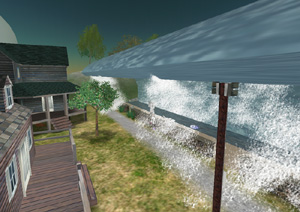 NOAA Tsunami Exhibit |
The Tsunami Exhibit takes visitors through the sequence of events leading to a catastrophic tidal wave. It begins with the sirens, followed by the waters receeding out to sea, then the tidal wave rolls in, taking down the life-sized houses set up along the shore, and leaving the visitor standing in the ruins of a small town.
Unlike a real tsunami, the NOAA’s display can then be reset, making the houses spring back up and setting everything back to the way they were.
NOAA Related Links:
Comprehensive Marine Education Resources
Ocean Related Career Opportunities
Educational Graphics on Global Climate Change and the Greenhouse Effect
Miscellany
 SL Royal Society |
The Royal Society, UK’s national academy of science, was something of a disappointment in Second Life, but that was because I was expecting to find the official headquarters for the academy. Instead, what I found was more of a gift-shop in a Renaissance-era community hidden in SL.
The unassuming building was apropo for the society’s humble beginnings, which actually began as a group of “natural philosophers who began meeting in the mid-1640s to discuss the ideas of Francis Bacon (history).” Inside the building there were decorations and wearables for SLers in the style of Renaissance and Englightenment-era science.
|
Terry Lightfoot |
The SL society has its own version of the Proceeding of the Royal Society, with abstracts such as “Wireless Transmission of Signals through the SL Aether” and “Cumulative effects of spontaneous bling.” So it seems that the SL Society is performing science, virtual science, only applicable to SL. It was cute, however useless.
The entire island on which the Royal Society building resides is one big Renfaire, filled with avatars wearing the most fantastic Renaissance-style clothing. The houses, with the exception of the Royal Society’s, were incredibly ornate as well. This was a very beautiful spot in SL, just not was I was looking for.
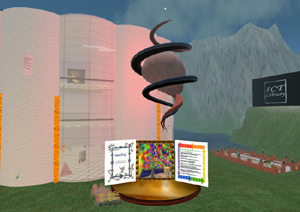 Shock Proof |
The SL Medical Library, located right by the Science Center, has Consumer Health Information, Breast Cancer Awareness, Medical Podcasts, Medical Research Information, NIH Displays, and Medical Art.
Right outside the building is a display for the “Shock Proof” stroke victims support community. Like using SL for computer simulation science experiments, I’m intrigued by this idea. I took a quick visit to the community, and found it still a work in progress after several months; however, there were plenty of avatars hanging out there. It is an interesting idea, possibly providing an environment for stroke victims to meet and collaborate.
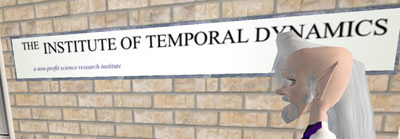 Institue of Temporal Dynamics |
The Institute of Temporal Dynamics has an active meeting place at their SL office. While the Nevada-based not for profit science institute is making excellent use of SL as a resource, I could not find a WWW site for the organization. Very odd.
On display at the institute were posters communicating research on “Water Flow Through Widespread and Interconnected Void Spaces at Depth in a Temperate Glacier (abstract).” These included charts, video imaging of “Planar Voids,” void distribution, connectivity and water flow.
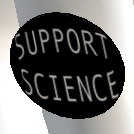 Support Science |
I would have had no idea what these findings were about if I had not seen Al Gores An Inconvenient Truth this year and knew that water flow through a glacier can cause it to break up dramatically. Greenland’s iceshelf is quickly becoming more porous, lubricating the space between the ice and ground beneath it. This is a natural process, but Global Warming is causing it to accelerate. ITD’s research into the dynamics of glacial hydrology is important for determing the threat-level global warming presents to Greenland’s Iceshelf.
Here I got my first object that I could put on my avatar: a button that reads “Support Science.”
Update: Thanks to Ben McGee of Temporal Dynamics, Inc for clarifying:
The website for the Institute of Temporal Dynamics, Inc., is “temporaldynamics.org” – We appreciate your stopping by the SL office and hope you’ll do so again – there are now weekly seminars concerning on-going research being offered in our expanded SL education center!
Comments
2 responses to “Science in Second Life”